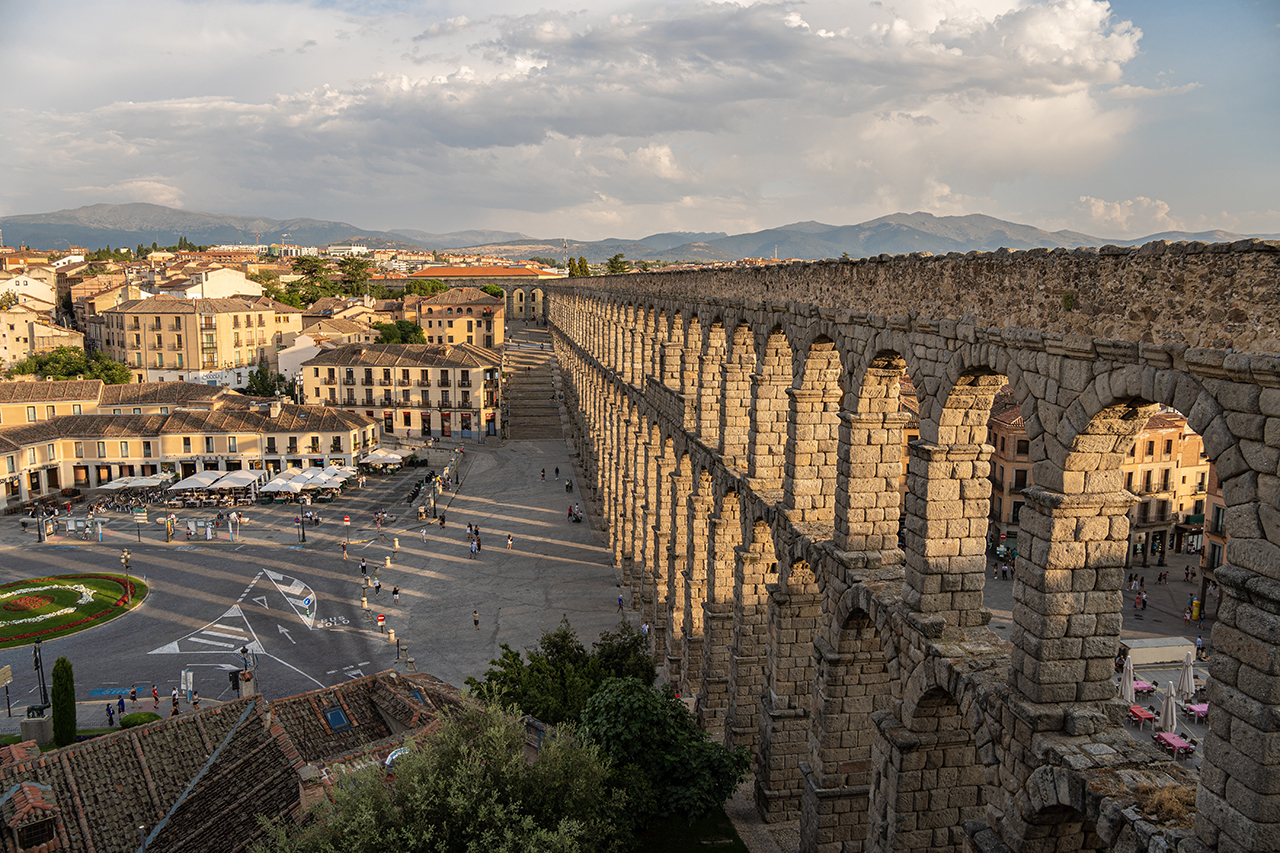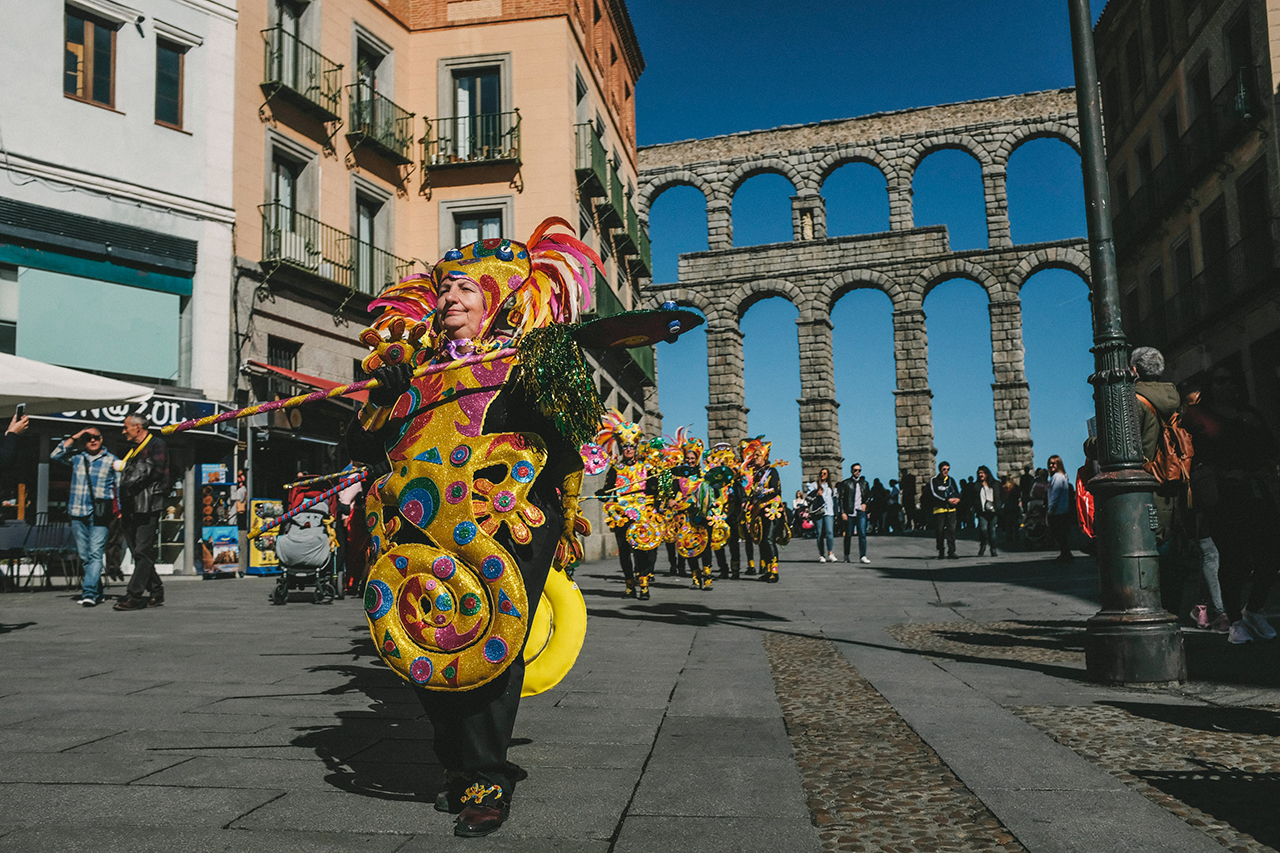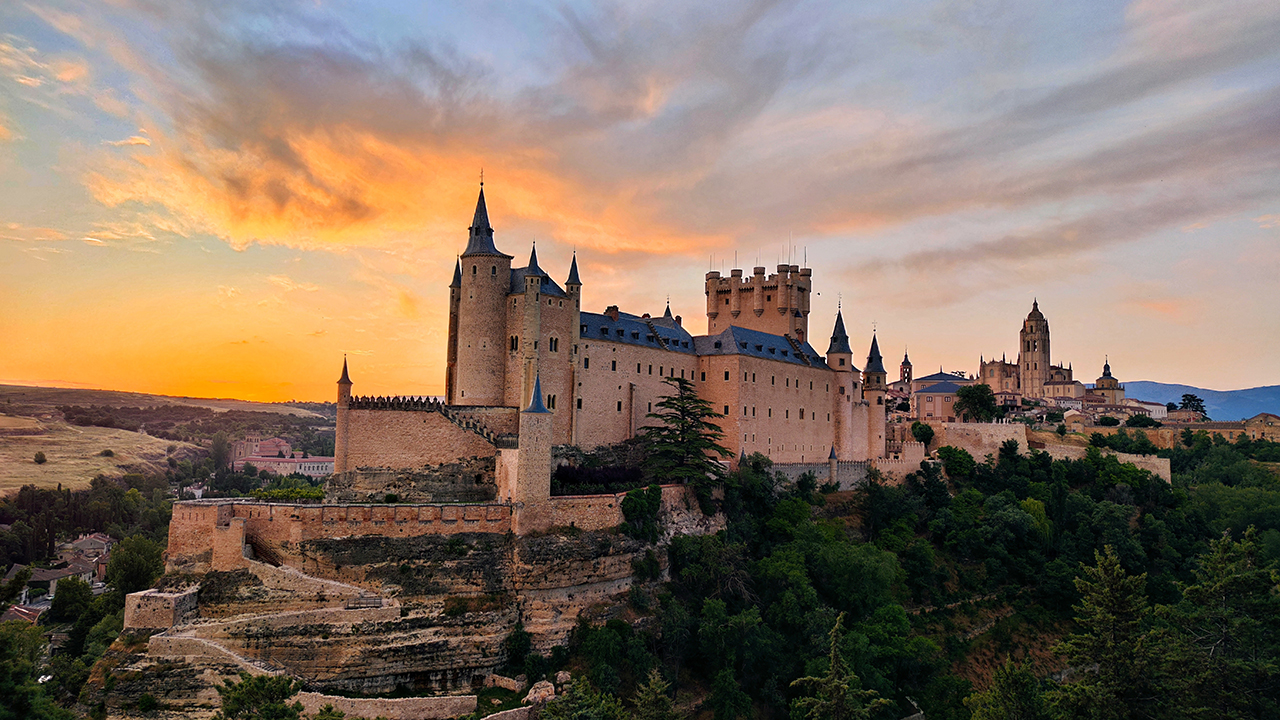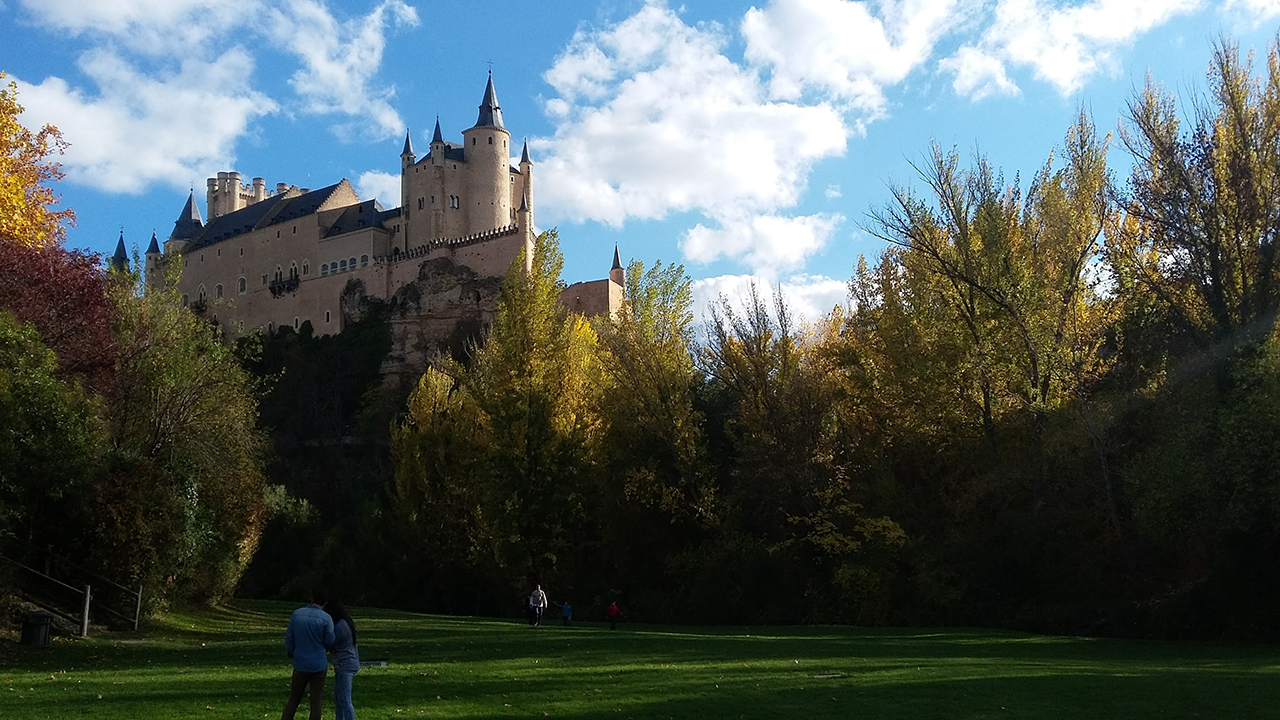INTRODUCTION
The Segovia Aqueduct, majestically standing in the heart of Castilla y León, is unquestionably one of the most astounding testaments to Roman ingenuity in Spain. Built in the 1st century AD, this monument has not only withstood the test of time but continues to play an active role in the urban landscape of Segovia, bridging its past with the present.
This formidable example of Roman architecture, composed of over 20,000 granite blocks without the use of mortar, spans almost 16 kilometers, though its most famous and photographed segment crosses the Plaza del Azoguejo. With its double arches and a peak height of 28 meters, it stands as an iconic image, emblematic not just of the city of Segovia, but of Spain as a whole.
The grandeur of its design and its near-pristine state of preservation, intact after two millennia, makes it a living testimony to the engineering skills of ancient Rome. Thus, it’s no surprise that in 1985, it was designated a UNESCO World Heritage Site, further cementing its global historical and cultural significance.
For those keen to discover more about this magnificent heritage and other treasures the city has in store, the Segovia Visitor Reception Centre provides detailed information and helpful resources for tourists (www.turismodesegovia.com). Here, visitors can find guides, maps, and everything needed for an unforgettable experience in this Castilian gem.

History and origins
The vast expanse of the Roman Empire left its indelible mark across many regions, with the Iberian Peninsula being no exception. The Romans’ arrival to what we now recognize as Spain introduced not only political and social shifts but also enduring technological and architectural advancements.
The construction of the Segovia Aqueduct took place in the 1st century AD, during a period of growth and stability for the Roman Empire under the Flavian dynasty. While the exact details of its construction remain a topic of debate among historians and archaeologists, its purpose is clear: to supply fresh and clean water to the city of Segovia, sourcing it from springs in the Sierra de Guadarrama mountains.
The aqueduct’s design showcases Roman mastery in hydraulic engineering. Its mortarless structure enabled water to flow by gravity from its source to the city. This awe-inspiring structure was not merely functional but also symbolized the grandeur and capability of the Roman Empire to harness and adapt the natural environment to its needs.
Throughout centuries, the aqueduct has withstood both natural and human challenges. During the Middle Ages, parts of the structure were repurposed as homes and shops, a practice later prohibited to maintain its integrity.
The Segovia Aqueduct is more than just an engineering marvel; it stands as a monument to human genius and the indomitable spirit of a civilization that, despite its challenges and declines, left legacies that continue to inspire awe.
For those wishing to delve deeper into Segovia’s Roman history and that of the peninsula, the Real Colegio de Artillería Museum in Segovia presents exhibits and resources highlighting Roman impact and influence in the region (www.alcázarofsegovia.com). Located within the iconic Alcázar of Segovia, this museum is a must-visit for history and architecture enthusiasts.
Architecture and sesign
The Segovia Aqueduct stands as a genuine masterpiece of Roman architectural design, bearing witness to the advanced knowledge and skill of its builders. While seemingly straightforward at first glance, it encompasses intricate details and features that classify it as a marvel of ancient engineering.
Constructed primarily using granite blocks without mortar, the stones are precisely set upon one another without any binding agent. This showcases the meticulous craftsmanship and assembly of these blocks, a remarkable feat enabling the structure to remain standing for nearly two millennia.
Stretching over 16 kilometers, the most iconic and well-preserved section crosses the Plaza del Azoguejo, boasting 167 arches with a peak height of 28 meters. The structure features two levels of superimposed arches, with smaller arches on top and larger ones below.
Regarding construction techniques, the Romans employed a system of wooden wedges that, when moistened, exerted pressure on the stones, ensuring a perfect fit. This method, combined with the use of scaffolding and ramps, facilitated the construction of this magnificent edifice.
One unique feature of the Segovia Aqueduct’s design lies in its water transport method. Without modern piping, Romans used a channel system with a slight incline, enabling water to flow by gravity from the mountain source to Segovia’s heart.
The aqueduct served not only as utilitarian infrastructure but also as a symbol of Rome’s power and grandeur, a tangible reminder of Roman expertise in mastering nature.
For those eager to learn more about Roman architecture and the design of similar structures, the Segovia Aqueduct Interpretation Centre offers detailed exhibits and educational resources on the subject (www.turismodesegovia.com). Situated near the monument, this center gives visitors a deep dive into the engineering and history behind this wondrous creation.

Cultural significance and heritage
The Aqueduct of Segovia is not merely a monumental construction; it is an emblem that mirrors the rich history and cultural heritage of Segovia and the whole of Spain. Its consistent presence over the centuries has solidified its status not only as an architectural marvel, but also as a silent witness to the evolution of the city and its people.
As a symbol of Segovia, the aqueduct has borne witness to countless historical events, from Roman dominion to modern times. It stands as a reminder of the influence and grandeur of the Roman Empire, yet has been adapted and adopted by successive generations, becoming a bridge between past and present. Images of the aqueduct grace everything from postcards to the city’s coat of arms and serve as a landmark for any visitor.
The significance of the Aqueduct of Segovia transcends national boundaries. In 1985, it was designated a World Heritage Site by UNESCO, an acknowledgment that underscores its exceptional universal value and the imperative to preserve it for future generations. This title not only affirms its architectural and historical relevance but also the pivotal role it plays in the cultural identity of Segovia and Spain at large.
Recognition by UNESCO has also led to renewed interest in the conservation and promotion of the aqueduct. Over the years, various restoration and maintenance works have been carried out to ensure this iconic monument stands tall for many more centuries.
For those seeking more information on the heritage value of the Aqueduct of Segovia and other sites of interest in Spain, the official UNESCO webpage offers detailed resources regarding its designation and significance (whc.unesco.org). Additionally, Segovia Tourism (www.turismodesegovia.com) provides guides, tours, and insights into the cultural and tourist relevance of this imposing monument.
Legends and myths
Much like many other ancient landmarks of importance, the Aqueduct of Segovia is cloaked in a shroud of mystery and legends passed down from generation to generation. These tales, rooted in regional folklore and oral tradition, add a magical and mystical dimension to this already awe-inspiring monument.
One of the most popular legends is the “Pact with the Devil.” As the story goes, a young maid, tired of hauling water from the river to the top of the city daily, called upon the devil and offered him her soul in exchange for an infrastructure that would automatically transport the water. The devil agreed and began constructing the aqueduct. They agreed that if the devil managed to finish the aqueduct before dawn and place the last stone, he would claim the young woman’s soul. However, with just one stone left to place, dawn broke, preventing the devil from completing his task and claiming the maid’s soul. To this day, if you closely inspect the aqueduct, legend holds that a stone is missing from its construction.
Another local tale contends that the aqueduct was not built by humans but by giants that once roamed the region. While clearly mythological, this story emphasizes the magnitude and wonder the structure inspires in those who behold it.
Such tales have become an integral part of Segovia’s cultural heritage, complementing the admiration the aqueduct elicits for its architectural and historical merits. Legends not only infuse the monument with an air of mystery but also connect visitors to the traditions and collective imagination of the local community.
For those keen on delving deeper into these captivating legends, Segovia Tourism offers themed tours that explore the folklore and local narratives tied to the Aqueduct and other city attractions (www.turismodesegovia.com). Furthermore, the Aqueduct Interpretation Center provides deeper insights into the monument and the tales surrounding it, offering a rewarding experience for those keen on understanding more about this emblematic heritage.

Visiting the aqueduct of Segovia
The Aqueduct of Segovia, with its magnificence and grandeur, is not just a monument to admire from afar. An up-close visit offers an opportunity to appreciate the intricate details and majesty of this Roman engineering masterpiece.
Best viewpoints and photography tips:
- Plaza del Azoguejo: Undoubtedly, this offers the most famous perspective of the Aqueduct. From here, one can behold the structure in its full height, making it the ideal spot for a panoramic photo.
- Mirador de la Canaleja: Located a short distance away, this viewpoint offers an elevated view of the Aqueduct and parts of the city. It’s particularly beautiful during sunset.
- From Calle Cervantes: As you approach the city’s old quarter, you gain a different perspective, looking along the Aqueduct’s length.
Practical information:
- Access: The Aqueduct is an open-air structure and can be visited year-round. There are no barriers or access restrictions, and it’s visible from various city points.
- Timings: While the Aqueduct itself doesn’t have specific timings, if you wish to visit the Aqueduct Interpretation Center, they have set hours. It’s recommended to visit their website or contact them directly for up-to-date information.
- Fees: Viewing and walking around the Aqueduct are entirely free. However, certain activities or guided tours from the Interpretation Center may incur a charge.
For those desiring a more enriching experience, Segovia Tourism (www.turismodesegovia.com) offers guided tours that cover not only the Aqueduct but also other city highlights, providing a comprehensive view of Segovia’s rich history and culture.
Other places of interest in Segovia
Beyond its iconic Aqueduct, Segovia houses a rich cultural and architectural mix waiting to be unveiled. This city, whose old town was declared a World Heritage Site by UNESCO, is a true gem blending history with timeless charm.
Alcázar of Segovia: One of Spain’s most distinctive fortresses, this fairy-tale castle has inspired several storybook palaces. With its pointed towers and location on a rocky promontory, the Alcázar not only offers a panoramic view of the city but also delves into the history and culture of the region. Inside, visitors are rewarded with lavishly decorated rooms and an extensive collection of armor. (www.alcazardesegovia.com)

Cathedral of Segovia: Known as “The Lady of Cathedrals” for its dimensions and elegance, it stands as a gem of late Gothic architecture. Its impressive tower, soaring to 88 meters, and its main altarpiece are just some of the highlights of this magnificent cathedral.
Jewish Quarter: Formerly a thriving Jewish community, this district provides insight into Segovia’s rich cultural tapestry. Wandering its narrow streets, one can visit the ancient synagogue and the educational center of the Judería, which offers a detailed interpretation of the Sephardic legacy in the city. (www.redjuderias.org)
House of Antonio Machado: The renowned Spanish poet Antonio Machado resided in Segovia for several years, and his house is now a museum dedicated to his life and work. Here, visitors can glean a personal insight into one of Spain’s greatest literary figures.
Monastery of Parral: A tranquil and serene monastery situated by the Eresma river. Its idyllic surroundings and remarkable architecture make it a perfect spot for reflection and contemplation.
These are just a few of the many treasures Segovia has in store. The city stands as a testament to Spain’s rich history, and a visit is essential for anyone wishing to immerse themselves in the country’s culture and tradition. For further details and recommendations, Turismo de Segovia (www.turismodesegovia.com) is a priceless source of information and advice.
Segovian gastronomy: a culinary complement to your visit
A trip to Segovia would be incomplete without diving into its rich culinary tradition. This city, renowned for its historical and cultural heritage, is also celebrated for its traditional cuisine, marrying local ingredients with age-old techniques to create mouth-watering dishes.
Roasted Suckling Pig (Cochinillo asado): Undoubtedly Segovia’s most emblematic dish. This tender piglet is slowly roasted in wood-fired ovens until its skin crisps up, while the inside meat remains juicy and tender. One of the most renowned places to savor it is at the José María Restaurant (www.restaurantejosemaria.com), where it’s prepared following the traditional recipe.

Judiones de La Granja: These large white beans are another regional specialty. They’re slow-cooked with chorizo, black pudding, and pork, culminating in a hearty and delightful stew.
Castilian Soup (Sopa Castellana): A garlic soup made with stale bread, garlic, paprika, and sometimes ham or chorizo. It’s a comforting dish bursting with flavor, perfect for cold days.
Segovian Punch (Ponche segoviano): A treat for dessert lovers. Made with sponge cake soaked in syrup, filled with custard cream, and topped with a glazed sugar layer, it’s the perfect ending to any meal.
Recommended Venues: Apart from the aforementioned José María Restaurant, Mesón de Cándido (www.mesondecandido.es) is another must-visit. Located next to the Aqueduct, it’s famed not just for its suckling pig but also its rich culinary history and tradition. Taverna Rubi offers a blend of traditional and modern dishes in a cozy setting.
Savoring Segovian cuisine is an experience that merges history, culture, and taste in an unforgettable culinary journey. It perfectly complements a tour of the city’s architectural and cultural gems. For more culinary recommendations and events, Turismo de Segovia (www.turismodesegovia.com) provides extensive information for food aficionados.
Events and celebrations
The city of Segovia, steeped in rich history and culture, also hosts numerous events and celebrations that attract both locals and tourists. Many of these events are directly related to the Aqueduct, while others take place in its vicinity, turning this iconic monument into a silent witness to the festivities.
- Fiesta de San Frutos: Celebrated on October 25, this festival pays tribute to the city’s patron saint, San Frutos. It’s a tradition to walk along the Aqueduct and enjoy the panoramic views of the city. Segovians also visit the Cathedral to pay homage to the saint.
- Heritage Night: This event, celebrated simultaneously in several cities of the Group of World Heritage Cities of Spain, includes cultural activities such as dances, concerts, and exhibitions. In Segovia, the Aqueduct is illuminated in a special way, creating a stunning visual display.
- Titirimundi, Segovia International Puppet Festival: While not focused solely on the Aqueduct, this renowned puppet festival takes place in various corners of the city, with performances commonly seen in squares and streets near the monument. It’s a delight for both children and adults (www.titirimundi.es).
- The Moons of the Aqueduct: During summer nights, the Aqueduct area transforms into a stage for various cultural performances, from concerts to theatrical plays, under the enchanting moonlight.
- Semana Santa of Segovia: This internationally renowned religious celebration features processions that often pass near the Aqueduct, offering an unparalleled backdrop to this deeply traditional event.
For more information about these events and others celebrated throughout the year in Segovia, Turismo de Segovia (www.turismodesegovia.com) is a valuable resource. Their portal provides details on dates, times, and locations of each celebration, allowing visitors to plan their stay in the city according to their interests.

Conclusions
The Segovia Aqueduct is not just an architectural marvel from the Roman era, but also a living testimony to the rich historical and cultural tapestry that Spain has woven over the centuries. This majestic structure has withstood the test of time, offering present and future generations a window into the past and human ingenuity. Its preservation and the pride with which the Segovians and Spaniards view it reflect the deep connection between heritage and national identity. When visiting Segovia and beholding the Aqueduct, one not only admires an architectural masterpiece but also immerses oneself in the collective narrative of a people and their evolution over time.
Additional resources and Links of interest
For those wishing to gain a deeper understanding of the Segovia Aqueduct and the city itself, there are several resources and links that can be invaluable:
- Turismo de Segovia: The official tourism portal for the city, offering detailed information about places of interest, events, and more. (www.turismodesegovia.com)
- National Heritage: Provides information on various heritage sites in Spain, including the Segovia Aqueduct. (www.patrimonionacional.es)
- Guides of Segovia: For those interested in guided tours around the city and the Aqueduct. Various companies offer tours that provide insights and intriguing facts about this monument.
- UNESCO – World Heritage: UNESCO’s official site provides details on why the Segovia Aqueduct was designated a World Heritage Site and its global relevance. (whc.unesco.org)
- Travel Forums and Blogs: Sites like TripAdvisor or specialized blogs can offer personal perspectives, tips, and recommendations from other travelers who’ve visited Segovia and its iconic Aqueduct.
These resources are just the starting point for a discovery adventure. Segovia, with its Aqueduct at the forefront, beckons everyone to explore, learn, and marvel at its rich historical and cultural blend.





